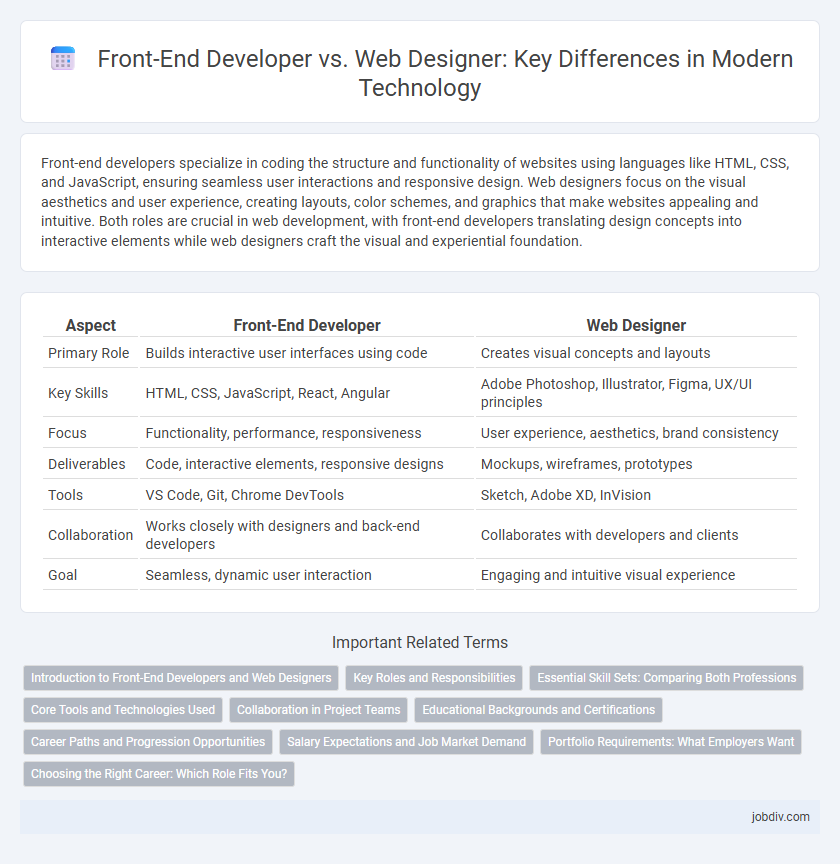Front-end developers specialize in coding the structure and functionality of websites using languages like HTML, CSS, and JavaScript, ensuring seamless user interactions and responsive design. Web designers focus on the visual aesthetics and user experience, creating layouts, color schemes, and graphics that make websites appealing and intuitive. Both roles are crucial in web development, with front-end developers translating design concepts into interactive elements while web designers craft the visual and experiential foundation.
Table of Comparison
| Aspect | Front-End Developer | Web Designer |
|---|---|---|
| Primary Role | Builds interactive user interfaces using code | Creates visual concepts and layouts |
| Key Skills | HTML, CSS, JavaScript, React, Angular | Adobe Photoshop, Illustrator, Figma, UX/UI principles |
| Focus | Functionality, performance, responsiveness | User experience, aesthetics, brand consistency |
| Deliverables | Code, interactive elements, responsive designs | Mockups, wireframes, prototypes |
| Tools | VS Code, Git, Chrome DevTools | Sketch, Adobe XD, InVision |
| Collaboration | Works closely with designers and back-end developers | Collaborates with developers and clients |
| Goal | Seamless, dynamic user interaction | Engaging and intuitive visual experience |
Introduction to Front-End Developers and Web Designers
Front-end developers specialize in converting design concepts into interactive, user-friendly websites using HTML, CSS, and JavaScript, ensuring responsive functionality across devices. Web designers focus on the visual aesthetics, user experience (UX), and overall layout, utilizing tools like Adobe XD and Figma to create engaging, intuitive interfaces. Both roles collaborate closely, with front-end developers implementing designs and optimizing performance while designers concentrate on branding, color schemes, and usability principles.
Key Roles and Responsibilities
Front-End Developers specialize in coding user interfaces using HTML, CSS, and JavaScript to create responsive and interactive websites, ensuring cross-browser compatibility and optimal performance. Web Designers focus on the visual aesthetics, user experience (UX), and layout design, using tools like Adobe XD, Sketch, or Figma to craft intuitive and visually appealing site prototypes. Both roles collaborate closely to align design concepts with functional implementation, enhancing overall website usability and engagement.
Essential Skill Sets: Comparing Both Professions
Front-end developers require strong proficiency in HTML, CSS, JavaScript, and frameworks like React or Angular to build responsive, interactive user interfaces that ensure seamless functionality. Web designers focus on creativity and mastery of graphic design tools such as Adobe Photoshop, Sketch, and Figma, prioritizing user experience and visual aesthetics. Both professions demand a deep understanding of UX/UI principles, but front-end developers emphasize coding skills while web designers excel in visual storytelling and layout design.
Core Tools and Technologies Used
Front-end developers primarily utilize HTML, CSS, and JavaScript frameworks like React, Angular, or Vue.js to build interactive and dynamic user interfaces. Web designers focus on graphic design software such as Adobe Photoshop, Sketch, and Figma to create visual layouts and user experience (UX) prototypes. Both roles often collaborate using version control systems like Git and prototyping tools to ensure cohesive website development and design integration.
Collaboration in Project Teams
Front-end developers and web designers collaborate closely by combining coding expertise with visual creativity to build cohesive and user-friendly websites. Web designers create detailed mockups and style guides that front-end developers translate into responsive, interactive interfaces using HTML, CSS, and JavaScript. Effective communication and shared knowledge of user experience (UX) principles streamline workflows, ensuring that aesthetic design aligns seamlessly with technical functionality.
Educational Backgrounds and Certifications
Front-End Developers typically possess educational backgrounds in computer science, software engineering, or related fields, often supplemented by certifications in JavaScript frameworks like React, Angular, or Vue.js. Web Designers usually have formal education in graphic design, visual arts, or user experience design, with certifications in tools such as Adobe Creative Suite, Sketch, or Figma. Both professions benefit from continuous learning through online platforms like Coursera, Udemy, and certifications from organizations like W3Schools and the Interaction Design Foundation.
Career Paths and Progression Opportunities
Front-end developers specialize in coding languages like HTML, CSS, and JavaScript to build interactive user interfaces, offering career progression into roles such as Senior Developer, UX Engineer, or Front-End Architect. Web designers focus on visual aesthetics, user experience, and graphic design tools like Adobe XD and Figma, with advancement opportunities leading to Senior Designer, UX/UI Specialist, or Creative Director. Both career paths benefit from continuous learning in emerging technologies and collaboration skills, but front-end developers often experience faster technical skill growth, while web designers emphasize creativity and brand consistency.
Salary Expectations and Job Market Demand
Front-end developers command higher salary expectations, averaging $75,000 to $110,000 annually, due to their coding expertise in HTML, CSS, and JavaScript, which is crucial for interactive web applications. The job market demand for front-end developers continues to grow rapidly, driven by expanding digital transformation across industries. Web designers typically earn between $50,000 and $70,000, with steady demand focused on UI/UX design skills, emphasizing creativity and user experience rather than programming.
Portfolio Requirements: What Employers Want
Employers seek front-end developer portfolios showcasing proficiency in HTML, CSS, JavaScript, and responsive design with real-world projects demonstrating coding skills and problem-solving ability. Web designer portfolios emphasize creativity, UX/UI design expertise, mastery of design tools like Adobe XD or Figma, and a diverse range of visually compelling projects. Both roles benefit from portfolios that highlight collaboration, attention to detail, and adaptability to evolving web technologies and design trends.
Choosing the Right Career: Which Role Fits You?
Front-end developers specialize in coding languages like HTML, CSS, and JavaScript to create interactive and responsive user interfaces, making them ideal for individuals who enjoy problem-solving and technical challenges. Web designers focus on visual aesthetics, usability, and user experience, utilizing tools like Adobe XD, Sketch, and Figma to craft appealing website layouts and graphics. Choosing the right career depends on whether you prefer the logical structure of programming or the creative process of design.
Front-End Developer vs Web Designer Infographic

 jobdiv.com
jobdiv.com